Developing a Risk Management System for Rail Passenger Operations
VerifiedAdded on 2023/06/13
|11
|2785
|424
Report
AI Summary
This report details a risk management system for establishing interstate rail passenger operations in Australia, focusing on a fleet of second-hand locomotives, maintenance facilities, and passenger handling. It addresses business risks, including rail safety, OHS, and regulatory compliance, emphasizing the importance of a comprehensive risk assessment matrix. The plan aims to mitigate risks related to staff fatigue, commercial factors like raw material prices, and safety measures aligned with Work Safe Victoria regulations. Key aspects include HRM integration with OHS, recruitment and training, and the roles of marketing, operations, and finance departments in maintaining safety and operational effectiveness. The document concludes by highlighting the need for continuous improvement and adaptation to ensure long-term sustainable results and employee well-being. Desklib provides this and other solved assignments to help students in their studies.
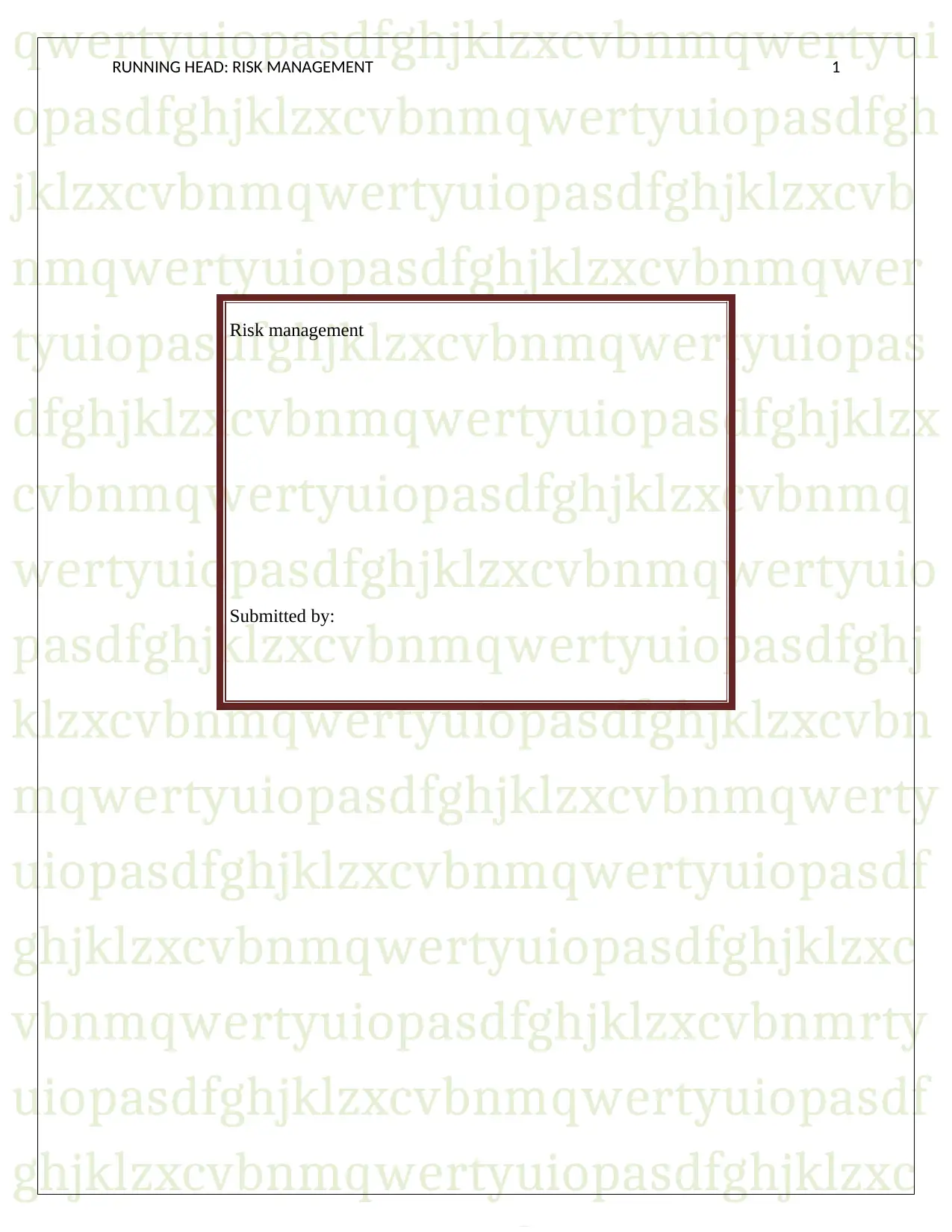
qwertyuiopasdfghjklzxcvbnmqwertyui
opasdfghjklzxcvbnmqwertyuiopasdfgh
jklzxcvbnmqwertyuiopasdfghjklzxcvb
nmqwertyuiopasdfghjklzxcvbnmqwer
tyuiopasdfghjklzxcvbnmqwertyuiopas
dfghjklzxcvbnmqwertyuiopasdfghjklzx
cvbnmqwertyuiopasdfghjklzxcvbnmq
wertyuiopasdfghjklzxcvbnmqwertyuio
pasdfghjklzxcvbnmqwertyuiopasdfghj
klzxcvbnmqwertyuiopasdfghjklzxcvbn
mqwertyuiopasdfghjklzxcvbnmqwerty
uiopasdfghjklzxcvbnmqwertyuiopasdf
ghjklzxcvbnmqwertyuiopasdfghjklzxc
vbnmqwertyuiopasdfghjklzxcvbnmrty
uiopasdfghjklzxcvbnmqwertyuiopasdf
ghjklzxcvbnmqwertyuiopasdfghjklzxc
RUNNING HEAD: RISK MANAGEMENT 1
Risk management
Submitted by:
opasdfghjklzxcvbnmqwertyuiopasdfgh
jklzxcvbnmqwertyuiopasdfghjklzxcvb
nmqwertyuiopasdfghjklzxcvbnmqwer
tyuiopasdfghjklzxcvbnmqwertyuiopas
dfghjklzxcvbnmqwertyuiopasdfghjklzx
cvbnmqwertyuiopasdfghjklzxcvbnmq
wertyuiopasdfghjklzxcvbnmqwertyuio
pasdfghjklzxcvbnmqwertyuiopasdfghj
klzxcvbnmqwertyuiopasdfghjklzxcvbn
mqwertyuiopasdfghjklzxcvbnmqwerty
uiopasdfghjklzxcvbnmqwertyuiopasdf
ghjklzxcvbnmqwertyuiopasdfghjklzxc
vbnmqwertyuiopasdfghjklzxcvbnmrty
uiopasdfghjklzxcvbnmqwertyuiopasdf
ghjklzxcvbnmqwertyuiopasdfghjklzxc
RUNNING HEAD: RISK MANAGEMENT 1
Risk management
Submitted by:
Paraphrase This Document
Need a fresh take? Get an instant paraphrase of this document with our AI Paraphraser
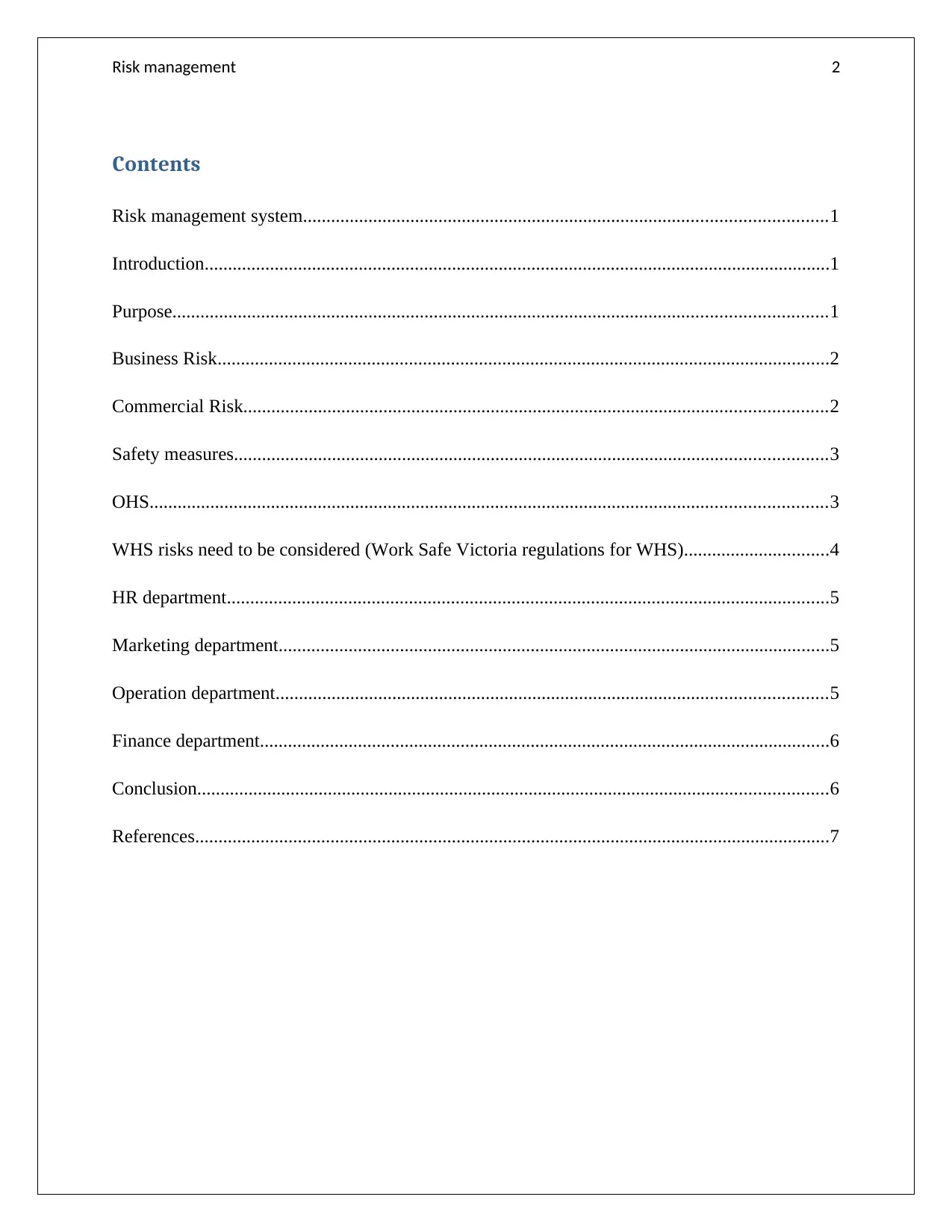
Risk management 2
Contents
Risk management system................................................................................................................1
Introduction......................................................................................................................................1
Purpose............................................................................................................................................1
Business Risk...................................................................................................................................2
Commercial Risk.............................................................................................................................2
Safety measures...............................................................................................................................3
OHS.................................................................................................................................................3
WHS risks need to be considered (Work Safe Victoria regulations for WHS)...............................4
HR department.................................................................................................................................5
Marketing department......................................................................................................................5
Operation department......................................................................................................................5
Finance department..........................................................................................................................6
Conclusion.......................................................................................................................................6
References........................................................................................................................................7
Contents
Risk management system................................................................................................................1
Introduction......................................................................................................................................1
Purpose............................................................................................................................................1
Business Risk...................................................................................................................................2
Commercial Risk.............................................................................................................................2
Safety measures...............................................................................................................................3
OHS.................................................................................................................................................3
WHS risks need to be considered (Work Safe Victoria regulations for WHS)...............................4
HR department.................................................................................................................................5
Marketing department......................................................................................................................5
Operation department......................................................................................................................5
Finance department..........................................................................................................................6
Conclusion.......................................................................................................................................6
References........................................................................................................................................7
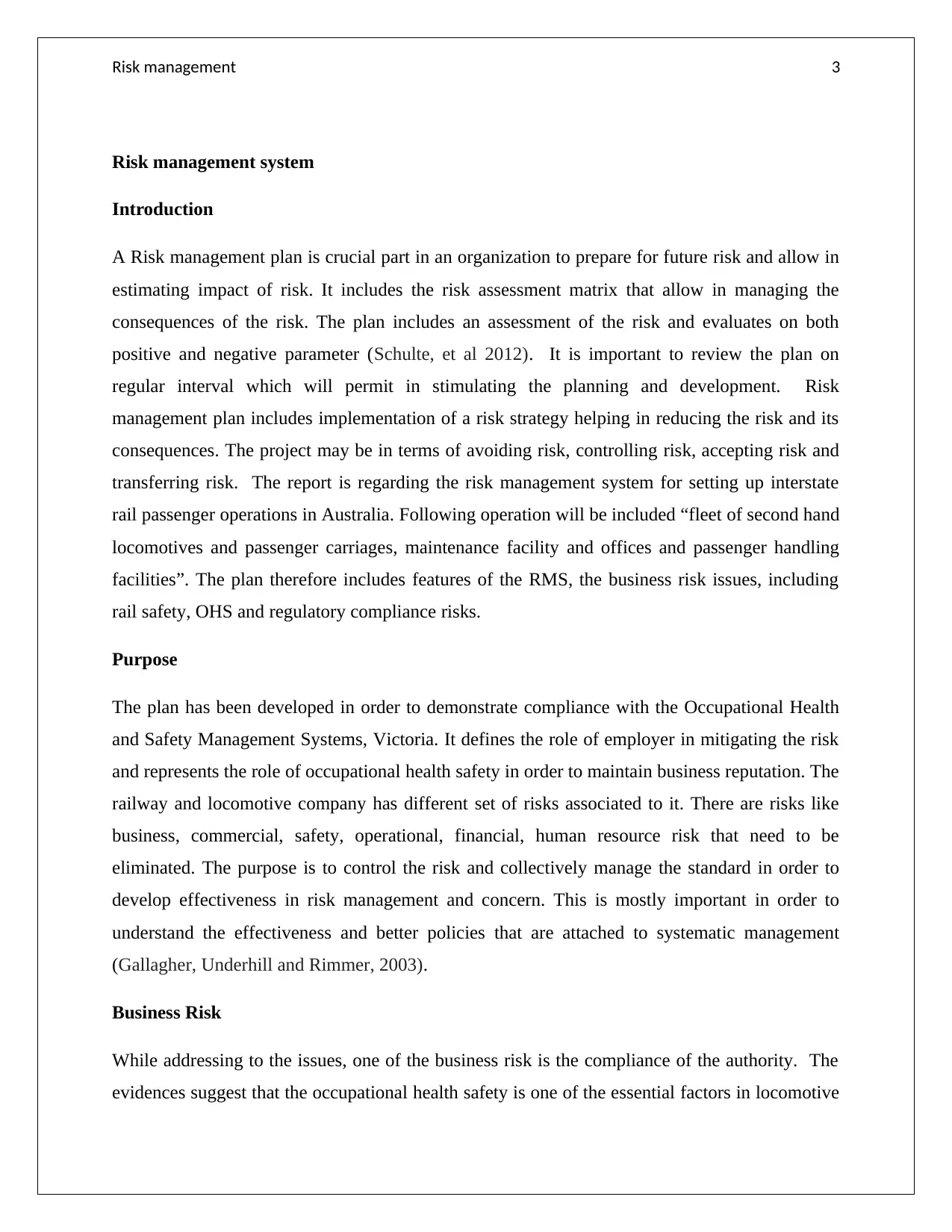
Risk management 3
Risk management system
Introduction
A Risk management plan is crucial part in an organization to prepare for future risk and allow in
estimating impact of risk. It includes the risk assessment matrix that allow in managing the
consequences of the risk. The plan includes an assessment of the risk and evaluates on both
positive and negative parameter (Schulte, et al 2012). It is important to review the plan on
regular interval which will permit in stimulating the planning and development. Risk
management plan includes implementation of a risk strategy helping in reducing the risk and its
consequences. The project may be in terms of avoiding risk, controlling risk, accepting risk and
transferring risk. The report is regarding the risk management system for setting up interstate
rail passenger operations in Australia. Following operation will be included “fleet of second hand
locomotives and passenger carriages, maintenance facility and offices and passenger handling
facilities”. The plan therefore includes features of the RMS, the business risk issues, including
rail safety, OHS and regulatory compliance risks.
Purpose
The plan has been developed in order to demonstrate compliance with the Occupational Health
and Safety Management Systems, Victoria. It defines the role of employer in mitigating the risk
and represents the role of occupational health safety in order to maintain business reputation. The
railway and locomotive company has different set of risks associated to it. There are risks like
business, commercial, safety, operational, financial, human resource risk that need to be
eliminated. The purpose is to control the risk and collectively manage the standard in order to
develop effectiveness in risk management and concern. This is mostly important in order to
understand the effectiveness and better policies that are attached to systematic management
(Gallagher, Underhill and Rimmer, 2003).
Business Risk
While addressing to the issues, one of the business risk is the compliance of the authority. The
evidences suggest that the occupational health safety is one of the essential factors in locomotive
Risk management system
Introduction
A Risk management plan is crucial part in an organization to prepare for future risk and allow in
estimating impact of risk. It includes the risk assessment matrix that allow in managing the
consequences of the risk. The plan includes an assessment of the risk and evaluates on both
positive and negative parameter (Schulte, et al 2012). It is important to review the plan on
regular interval which will permit in stimulating the planning and development. Risk
management plan includes implementation of a risk strategy helping in reducing the risk and its
consequences. The project may be in terms of avoiding risk, controlling risk, accepting risk and
transferring risk. The report is regarding the risk management system for setting up interstate
rail passenger operations in Australia. Following operation will be included “fleet of second hand
locomotives and passenger carriages, maintenance facility and offices and passenger handling
facilities”. The plan therefore includes features of the RMS, the business risk issues, including
rail safety, OHS and regulatory compliance risks.
Purpose
The plan has been developed in order to demonstrate compliance with the Occupational Health
and Safety Management Systems, Victoria. It defines the role of employer in mitigating the risk
and represents the role of occupational health safety in order to maintain business reputation. The
railway and locomotive company has different set of risks associated to it. There are risks like
business, commercial, safety, operational, financial, human resource risk that need to be
eliminated. The purpose is to control the risk and collectively manage the standard in order to
develop effectiveness in risk management and concern. This is mostly important in order to
understand the effectiveness and better policies that are attached to systematic management
(Gallagher, Underhill and Rimmer, 2003).
Business Risk
While addressing to the issues, one of the business risk is the compliance of the authority. The
evidences suggest that the occupational health safety is one of the essential factors in locomotive
⊘ This is a preview!⊘
Do you want full access?
Subscribe today to unlock all pages.

Trusted by 1+ million students worldwide
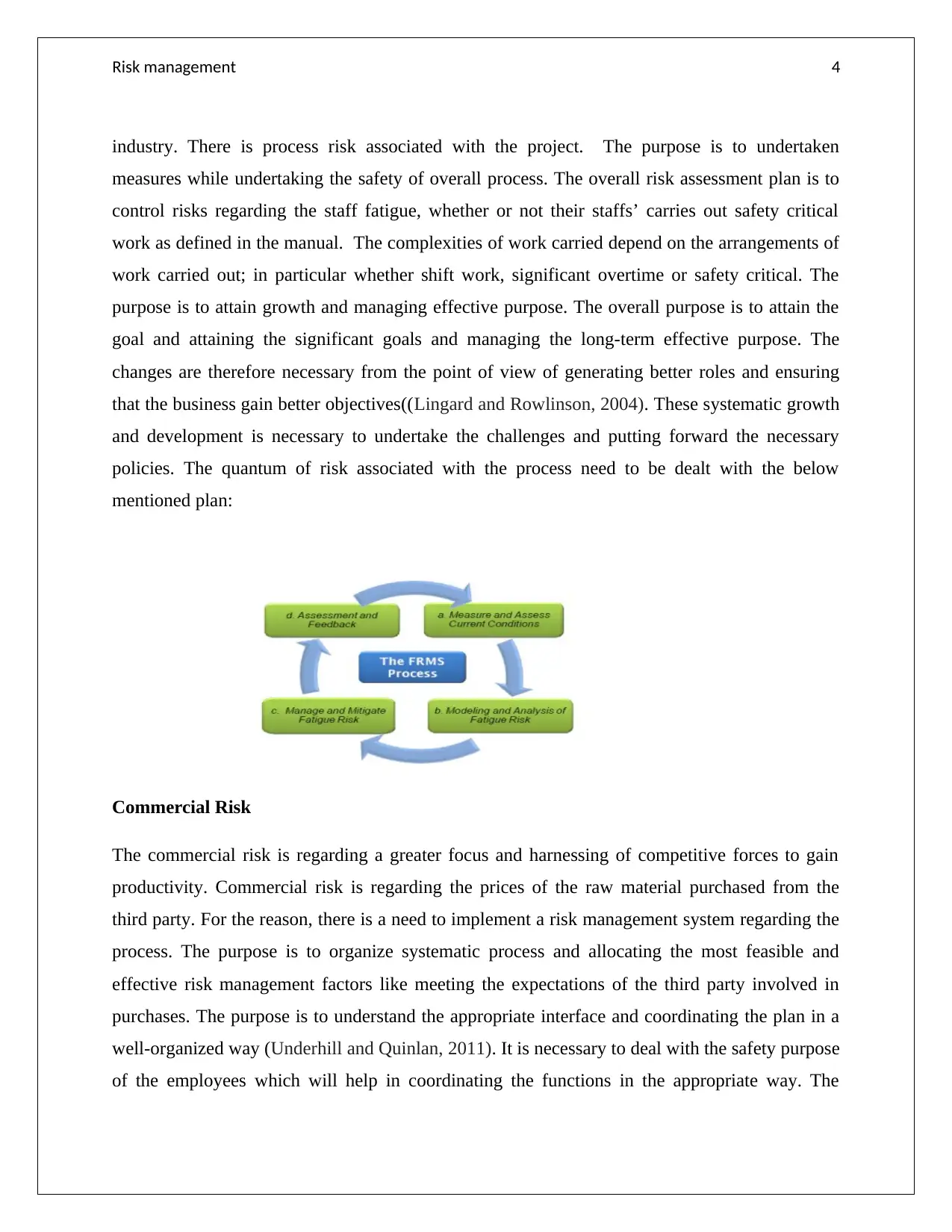
Risk management 4
industry. There is process risk associated with the project. The purpose is to undertaken
measures while undertaking the safety of overall process. The overall risk assessment plan is to
control risks regarding the staff fatigue, whether or not their staffs’ carries out safety critical
work as defined in the manual. The complexities of work carried depend on the arrangements of
work carried out; in particular whether shift work, significant overtime or safety critical. The
purpose is to attain growth and managing effective purpose. The overall purpose is to attain the
goal and attaining the significant goals and managing the long-term effective purpose. The
changes are therefore necessary from the point of view of generating better roles and ensuring
that the business gain better objectives((Lingard and Rowlinson, 2004). These systematic growth
and development is necessary to undertake the challenges and putting forward the necessary
policies. The quantum of risk associated with the process need to be dealt with the below
mentioned plan:
Commercial Risk
The commercial risk is regarding a greater focus and harnessing of competitive forces to gain
productivity. Commercial risk is regarding the prices of the raw material purchased from the
third party. For the reason, there is a need to implement a risk management system regarding the
process. The purpose is to organize systematic process and allocating the most feasible and
effective risk management factors like meeting the expectations of the third party involved in
purchases. The purpose is to understand the appropriate interface and coordinating the plan in a
well-organized way (Underhill and Quinlan, 2011). It is necessary to deal with the safety purpose
of the employees which will help in coordinating the functions in the appropriate way. The
industry. There is process risk associated with the project. The purpose is to undertaken
measures while undertaking the safety of overall process. The overall risk assessment plan is to
control risks regarding the staff fatigue, whether or not their staffs’ carries out safety critical
work as defined in the manual. The complexities of work carried depend on the arrangements of
work carried out; in particular whether shift work, significant overtime or safety critical. The
purpose is to attain growth and managing effective purpose. The overall purpose is to attain the
goal and attaining the significant goals and managing the long-term effective purpose. The
changes are therefore necessary from the point of view of generating better roles and ensuring
that the business gain better objectives((Lingard and Rowlinson, 2004). These systematic growth
and development is necessary to undertake the challenges and putting forward the necessary
policies. The quantum of risk associated with the process need to be dealt with the below
mentioned plan:
Commercial Risk
The commercial risk is regarding a greater focus and harnessing of competitive forces to gain
productivity. Commercial risk is regarding the prices of the raw material purchased from the
third party. For the reason, there is a need to implement a risk management system regarding the
process. The purpose is to organize systematic process and allocating the most feasible and
effective risk management factors like meeting the expectations of the third party involved in
purchases. The purpose is to understand the appropriate interface and coordinating the plan in a
well-organized way (Underhill and Quinlan, 2011). It is necessary to deal with the safety purpose
of the employees which will help in coordinating the functions in the appropriate way. The
Paraphrase This Document
Need a fresh take? Get an instant paraphrase of this document with our AI Paraphraser
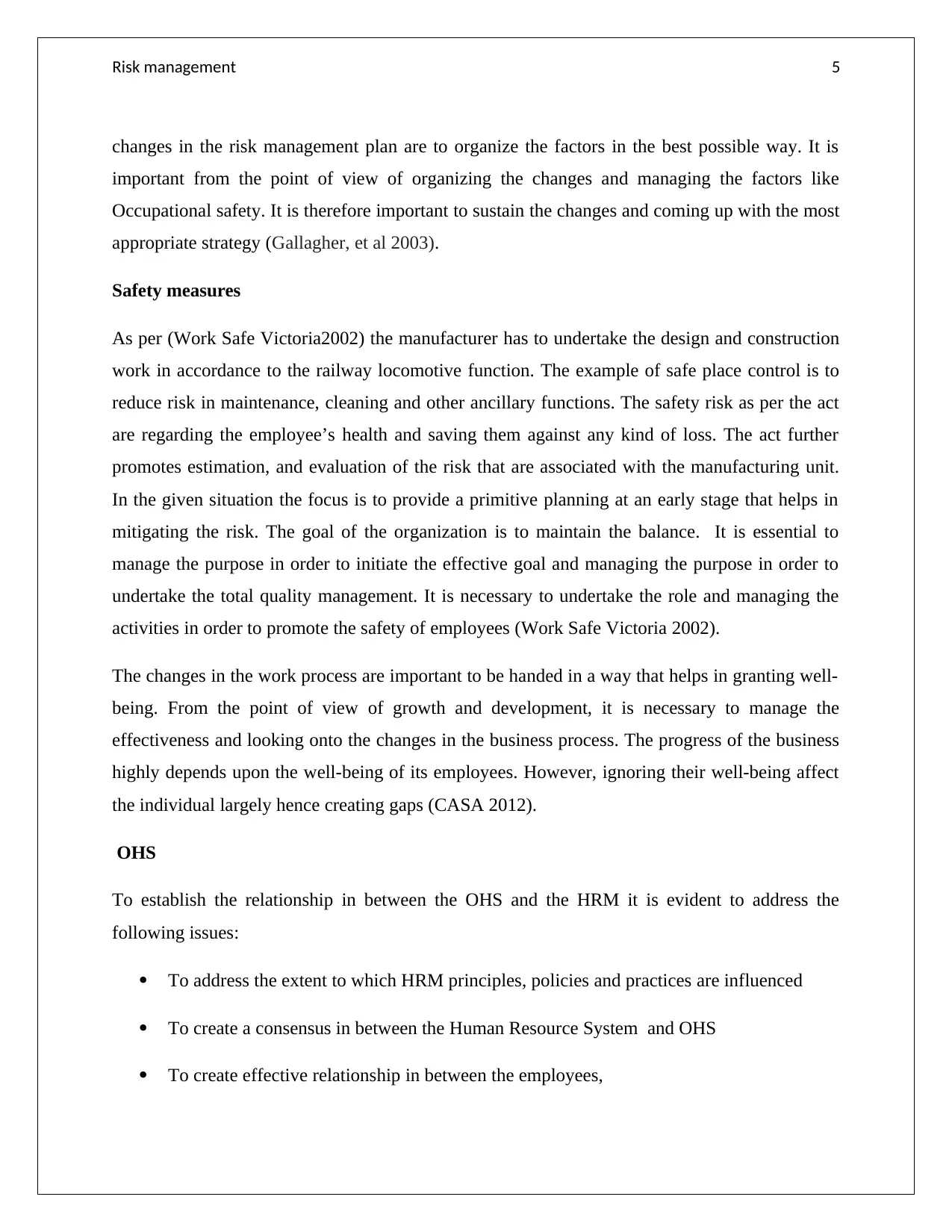
Risk management 5
changes in the risk management plan are to organize the factors in the best possible way. It is
important from the point of view of organizing the changes and managing the factors like
Occupational safety. It is therefore important to sustain the changes and coming up with the most
appropriate strategy (Gallagher, et al 2003).
Safety measures
As per (Work Safe Victoria2002) the manufacturer has to undertake the design and construction
work in accordance to the railway locomotive function. The example of safe place control is to
reduce risk in maintenance, cleaning and other ancillary functions. The safety risk as per the act
are regarding the employee’s health and saving them against any kind of loss. The act further
promotes estimation, and evaluation of the risk that are associated with the manufacturing unit.
In the given situation the focus is to provide a primitive planning at an early stage that helps in
mitigating the risk. The goal of the organization is to maintain the balance. It is essential to
manage the purpose in order to initiate the effective goal and managing the purpose in order to
undertake the total quality management. It is necessary to undertake the role and managing the
activities in order to promote the safety of employees (Work Safe Victoria 2002).
The changes in the work process are important to be handed in a way that helps in granting well-
being. From the point of view of growth and development, it is necessary to manage the
effectiveness and looking onto the changes in the business process. The progress of the business
highly depends upon the well-being of its employees. However, ignoring their well-being affect
the individual largely hence creating gaps (CASA 2012).
OHS
To establish the relationship in between the OHS and the HRM it is evident to address the
following issues:
To address the extent to which HRM principles, policies and practices are influenced
To create a consensus in between the Human Resource System and OHS
To create effective relationship in between the employees,
changes in the risk management plan are to organize the factors in the best possible way. It is
important from the point of view of organizing the changes and managing the factors like
Occupational safety. It is therefore important to sustain the changes and coming up with the most
appropriate strategy (Gallagher, et al 2003).
Safety measures
As per (Work Safe Victoria2002) the manufacturer has to undertake the design and construction
work in accordance to the railway locomotive function. The example of safe place control is to
reduce risk in maintenance, cleaning and other ancillary functions. The safety risk as per the act
are regarding the employee’s health and saving them against any kind of loss. The act further
promotes estimation, and evaluation of the risk that are associated with the manufacturing unit.
In the given situation the focus is to provide a primitive planning at an early stage that helps in
mitigating the risk. The goal of the organization is to maintain the balance. It is essential to
manage the purpose in order to initiate the effective goal and managing the purpose in order to
undertake the total quality management. It is necessary to undertake the role and managing the
activities in order to promote the safety of employees (Work Safe Victoria 2002).
The changes in the work process are important to be handed in a way that helps in granting well-
being. From the point of view of growth and development, it is necessary to manage the
effectiveness and looking onto the changes in the business process. The progress of the business
highly depends upon the well-being of its employees. However, ignoring their well-being affect
the individual largely hence creating gaps (CASA 2012).
OHS
To establish the relationship in between the OHS and the HRM it is evident to address the
following issues:
To address the extent to which HRM principles, policies and practices are influenced
To create a consensus in between the Human Resource System and OHS
To create effective relationship in between the employees,
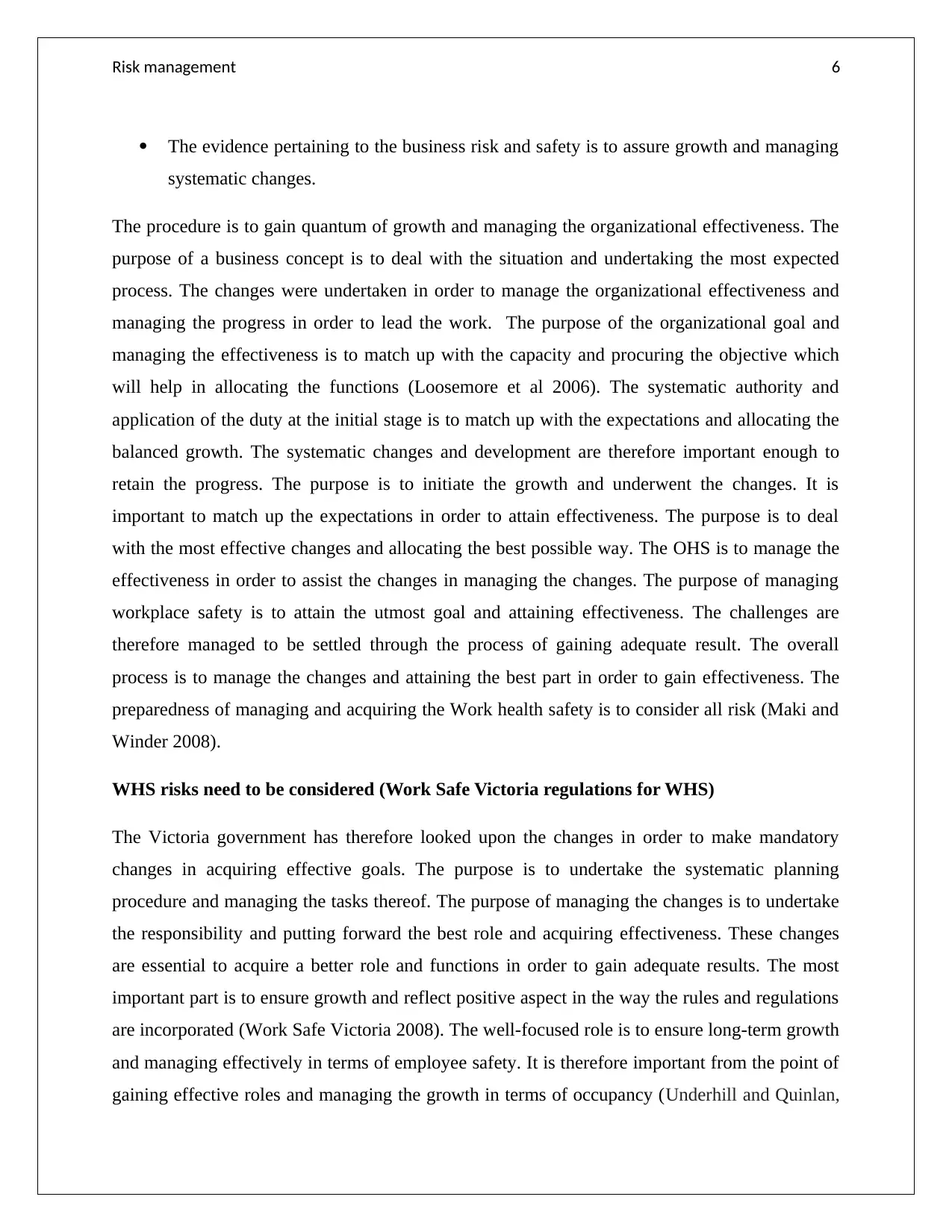
Risk management 6
The evidence pertaining to the business risk and safety is to assure growth and managing
systematic changes.
The procedure is to gain quantum of growth and managing the organizational effectiveness. The
purpose of a business concept is to deal with the situation and undertaking the most expected
process. The changes were undertaken in order to manage the organizational effectiveness and
managing the progress in order to lead the work. The purpose of the organizational goal and
managing the effectiveness is to match up with the capacity and procuring the objective which
will help in allocating the functions (Loosemore et al 2006). The systematic authority and
application of the duty at the initial stage is to match up with the expectations and allocating the
balanced growth. The systematic changes and development are therefore important enough to
retain the progress. The purpose is to initiate the growth and underwent the changes. It is
important to match up the expectations in order to attain effectiveness. The purpose is to deal
with the most effective changes and allocating the best possible way. The OHS is to manage the
effectiveness in order to assist the changes in managing the changes. The purpose of managing
workplace safety is to attain the utmost goal and attaining effectiveness. The challenges are
therefore managed to be settled through the process of gaining adequate result. The overall
process is to manage the changes and attaining the best part in order to gain effectiveness. The
preparedness of managing and acquiring the Work health safety is to consider all risk (Maki and
Winder 2008).
WHS risks need to be considered (Work Safe Victoria regulations for WHS)
The Victoria government has therefore looked upon the changes in order to make mandatory
changes in acquiring effective goals. The purpose is to undertake the systematic planning
procedure and managing the tasks thereof. The purpose of managing the changes is to undertake
the responsibility and putting forward the best role and acquiring effectiveness. These changes
are essential to acquire a better role and functions in order to gain adequate results. The most
important part is to ensure growth and reflect positive aspect in the way the rules and regulations
are incorporated (Work Safe Victoria 2008). The well-focused role is to ensure long-term growth
and managing effectively in terms of employee safety. It is therefore important from the point of
gaining effective roles and managing the growth in terms of occupancy (Underhill and Quinlan,
The evidence pertaining to the business risk and safety is to assure growth and managing
systematic changes.
The procedure is to gain quantum of growth and managing the organizational effectiveness. The
purpose of a business concept is to deal with the situation and undertaking the most expected
process. The changes were undertaken in order to manage the organizational effectiveness and
managing the progress in order to lead the work. The purpose of the organizational goal and
managing the effectiveness is to match up with the capacity and procuring the objective which
will help in allocating the functions (Loosemore et al 2006). The systematic authority and
application of the duty at the initial stage is to match up with the expectations and allocating the
balanced growth. The systematic changes and development are therefore important enough to
retain the progress. The purpose is to initiate the growth and underwent the changes. It is
important to match up the expectations in order to attain effectiveness. The purpose is to deal
with the most effective changes and allocating the best possible way. The OHS is to manage the
effectiveness in order to assist the changes in managing the changes. The purpose of managing
workplace safety is to attain the utmost goal and attaining effectiveness. The challenges are
therefore managed to be settled through the process of gaining adequate result. The overall
process is to manage the changes and attaining the best part in order to gain effectiveness. The
preparedness of managing and acquiring the Work health safety is to consider all risk (Maki and
Winder 2008).
WHS risks need to be considered (Work Safe Victoria regulations for WHS)
The Victoria government has therefore looked upon the changes in order to make mandatory
changes in acquiring effective goals. The purpose is to undertake the systematic planning
procedure and managing the tasks thereof. The purpose of managing the changes is to undertake
the responsibility and putting forward the best role and acquiring effectiveness. These changes
are essential to acquire a better role and functions in order to gain adequate results. The most
important part is to ensure growth and reflect positive aspect in the way the rules and regulations
are incorporated (Work Safe Victoria 2008). The well-focused role is to ensure long-term growth
and managing effectively in terms of employee safety. It is therefore important from the point of
gaining effective roles and managing the growth in terms of occupancy (Underhill and Quinlan,
⊘ This is a preview!⊘
Do you want full access?
Subscribe today to unlock all pages.

Trusted by 1+ million students worldwide
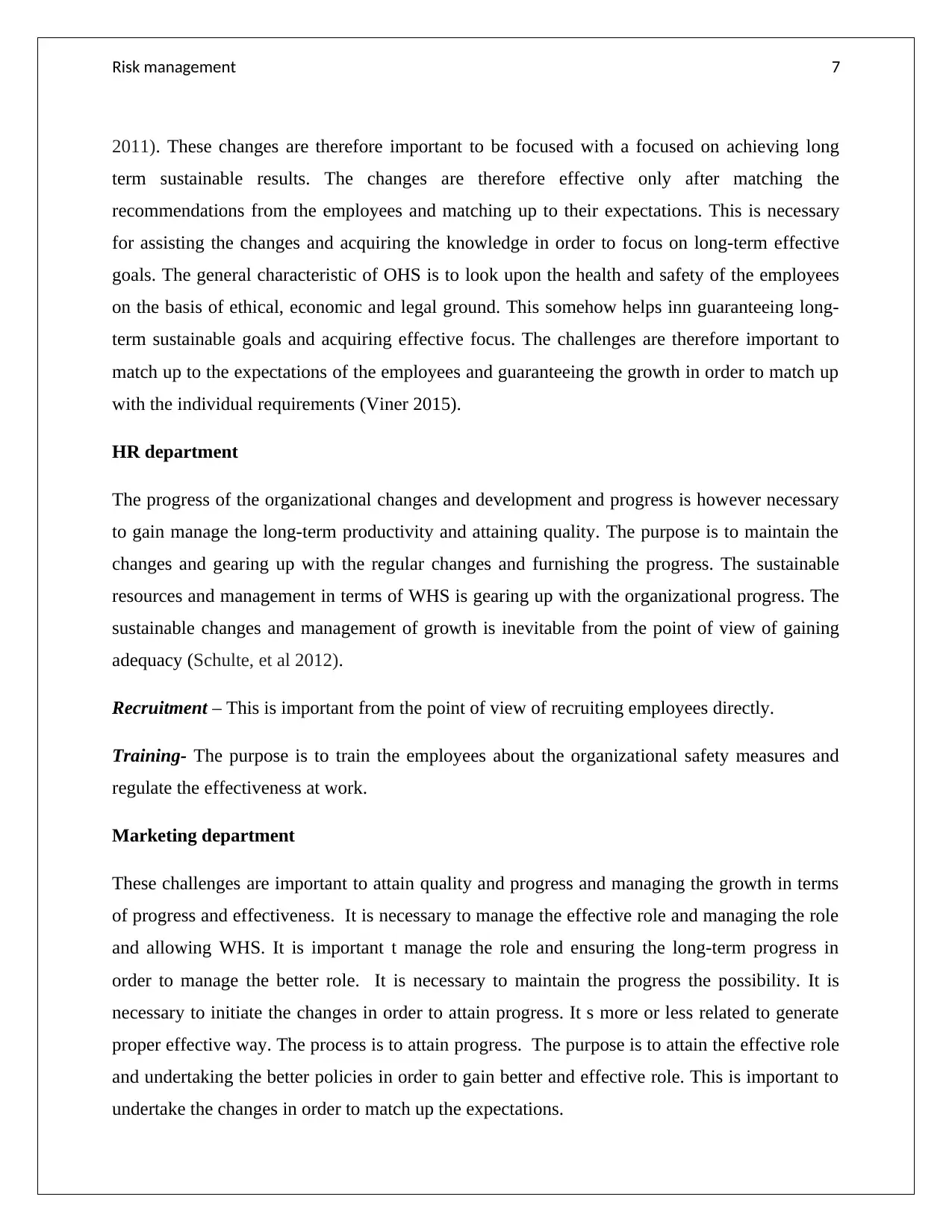
Risk management 7
2011). These changes are therefore important to be focused with a focused on achieving long
term sustainable results. The changes are therefore effective only after matching the
recommendations from the employees and matching up to their expectations. This is necessary
for assisting the changes and acquiring the knowledge in order to focus on long-term effective
goals. The general characteristic of OHS is to look upon the health and safety of the employees
on the basis of ethical, economic and legal ground. This somehow helps inn guaranteeing long-
term sustainable goals and acquiring effective focus. The challenges are therefore important to
match up to the expectations of the employees and guaranteeing the growth in order to match up
with the individual requirements (Viner 2015).
HR department
The progress of the organizational changes and development and progress is however necessary
to gain manage the long-term productivity and attaining quality. The purpose is to maintain the
changes and gearing up with the regular changes and furnishing the progress. The sustainable
resources and management in terms of WHS is gearing up with the organizational progress. The
sustainable changes and management of growth is inevitable from the point of view of gaining
adequacy (Schulte, et al 2012).
Recruitment – This is important from the point of view of recruiting employees directly.
Training- The purpose is to train the employees about the organizational safety measures and
regulate the effectiveness at work.
Marketing department
These challenges are important to attain quality and progress and managing the growth in terms
of progress and effectiveness. It is necessary to manage the effective role and managing the role
and allowing WHS. It is important t manage the role and ensuring the long-term progress in
order to manage the better role. It is necessary to maintain the progress the possibility. It is
necessary to initiate the changes in order to attain progress. It s more or less related to generate
proper effective way. The process is to attain progress. The purpose is to attain the effective role
and undertaking the better policies in order to gain better and effective role. This is important to
undertake the changes in order to match up the expectations.
2011). These changes are therefore important to be focused with a focused on achieving long
term sustainable results. The changes are therefore effective only after matching the
recommendations from the employees and matching up to their expectations. This is necessary
for assisting the changes and acquiring the knowledge in order to focus on long-term effective
goals. The general characteristic of OHS is to look upon the health and safety of the employees
on the basis of ethical, economic and legal ground. This somehow helps inn guaranteeing long-
term sustainable goals and acquiring effective focus. The challenges are therefore important to
match up to the expectations of the employees and guaranteeing the growth in order to match up
with the individual requirements (Viner 2015).
HR department
The progress of the organizational changes and development and progress is however necessary
to gain manage the long-term productivity and attaining quality. The purpose is to maintain the
changes and gearing up with the regular changes and furnishing the progress. The sustainable
resources and management in terms of WHS is gearing up with the organizational progress. The
sustainable changes and management of growth is inevitable from the point of view of gaining
adequacy (Schulte, et al 2012).
Recruitment – This is important from the point of view of recruiting employees directly.
Training- The purpose is to train the employees about the organizational safety measures and
regulate the effectiveness at work.
Marketing department
These challenges are important to attain quality and progress and managing the growth in terms
of progress and effectiveness. It is necessary to manage the effective role and managing the role
and allowing WHS. It is important t manage the role and ensuring the long-term progress in
order to manage the better role. It is necessary to maintain the progress the possibility. It is
necessary to initiate the changes in order to attain progress. It s more or less related to generate
proper effective way. The process is to attain progress. The purpose is to attain the effective role
and undertaking the better policies in order to gain better and effective role. This is important to
undertake the changes in order to match up the expectations.
Paraphrase This Document
Need a fresh take? Get an instant paraphrase of this document with our AI Paraphraser
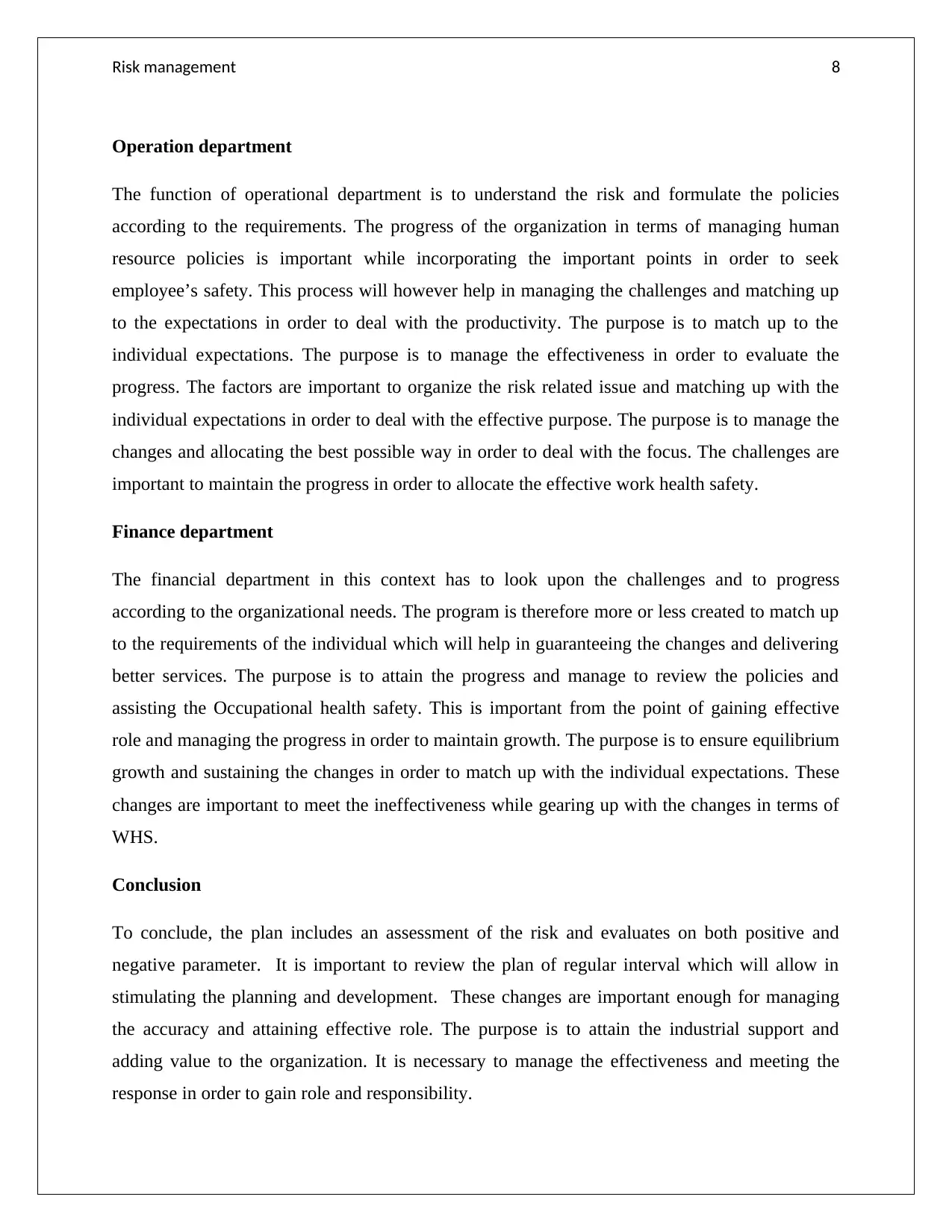
Risk management 8
Operation department
The function of operational department is to understand the risk and formulate the policies
according to the requirements. The progress of the organization in terms of managing human
resource policies is important while incorporating the important points in order to seek
employee’s safety. This process will however help in managing the challenges and matching up
to the expectations in order to deal with the productivity. The purpose is to match up to the
individual expectations. The purpose is to manage the effectiveness in order to evaluate the
progress. The factors are important to organize the risk related issue and matching up with the
individual expectations in order to deal with the effective purpose. The purpose is to manage the
changes and allocating the best possible way in order to deal with the focus. The challenges are
important to maintain the progress in order to allocate the effective work health safety.
Finance department
The financial department in this context has to look upon the challenges and to progress
according to the organizational needs. The program is therefore more or less created to match up
to the requirements of the individual which will help in guaranteeing the changes and delivering
better services. The purpose is to attain the progress and manage to review the policies and
assisting the Occupational health safety. This is important from the point of gaining effective
role and managing the progress in order to maintain growth. The purpose is to ensure equilibrium
growth and sustaining the changes in order to match up with the individual expectations. These
changes are important to meet the ineffectiveness while gearing up with the changes in terms of
WHS.
Conclusion
To conclude, the plan includes an assessment of the risk and evaluates on both positive and
negative parameter. It is important to review the plan of regular interval which will allow in
stimulating the planning and development. These changes are important enough for managing
the accuracy and attaining effective role. The purpose is to attain the industrial support and
adding value to the organization. It is necessary to manage the effectiveness and meeting the
response in order to gain role and responsibility.
Operation department
The function of operational department is to understand the risk and formulate the policies
according to the requirements. The progress of the organization in terms of managing human
resource policies is important while incorporating the important points in order to seek
employee’s safety. This process will however help in managing the challenges and matching up
to the expectations in order to deal with the productivity. The purpose is to match up to the
individual expectations. The purpose is to manage the effectiveness in order to evaluate the
progress. The factors are important to organize the risk related issue and matching up with the
individual expectations in order to deal with the effective purpose. The purpose is to manage the
changes and allocating the best possible way in order to deal with the focus. The challenges are
important to maintain the progress in order to allocate the effective work health safety.
Finance department
The financial department in this context has to look upon the challenges and to progress
according to the organizational needs. The program is therefore more or less created to match up
to the requirements of the individual which will help in guaranteeing the changes and delivering
better services. The purpose is to attain the progress and manage to review the policies and
assisting the Occupational health safety. This is important from the point of gaining effective
role and managing the progress in order to maintain growth. The purpose is to ensure equilibrium
growth and sustaining the changes in order to match up with the individual expectations. These
changes are important to meet the ineffectiveness while gearing up with the changes in terms of
WHS.
Conclusion
To conclude, the plan includes an assessment of the risk and evaluates on both positive and
negative parameter. It is important to review the plan of regular interval which will allow in
stimulating the planning and development. These changes are important enough for managing
the accuracy and attaining effective role. The purpose is to attain the industrial support and
adding value to the organization. It is necessary to manage the effectiveness and meeting the
response in order to gain role and responsibility.
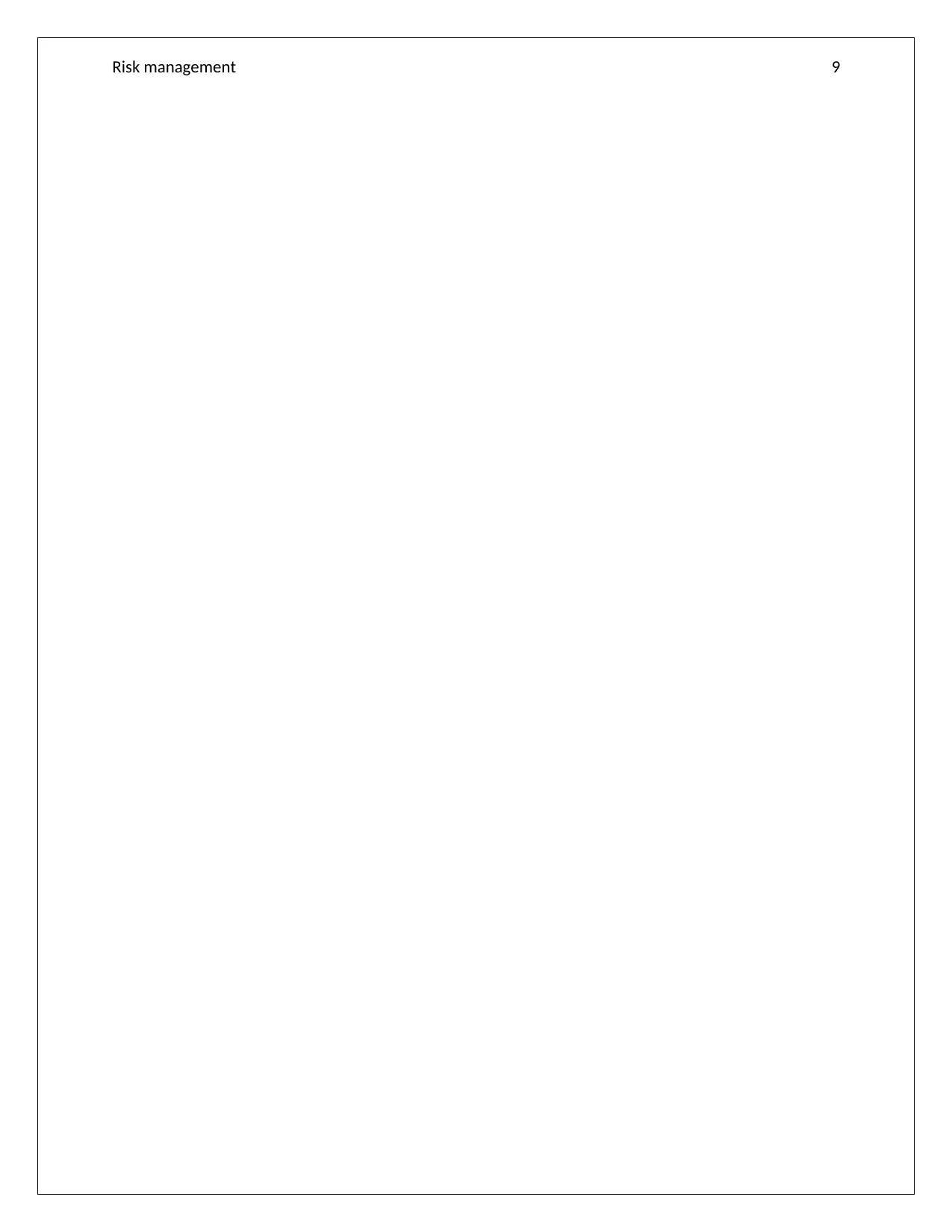
Risk management 9
⊘ This is a preview!⊘
Do you want full access?
Subscribe today to unlock all pages.

Trusted by 1+ million students worldwide
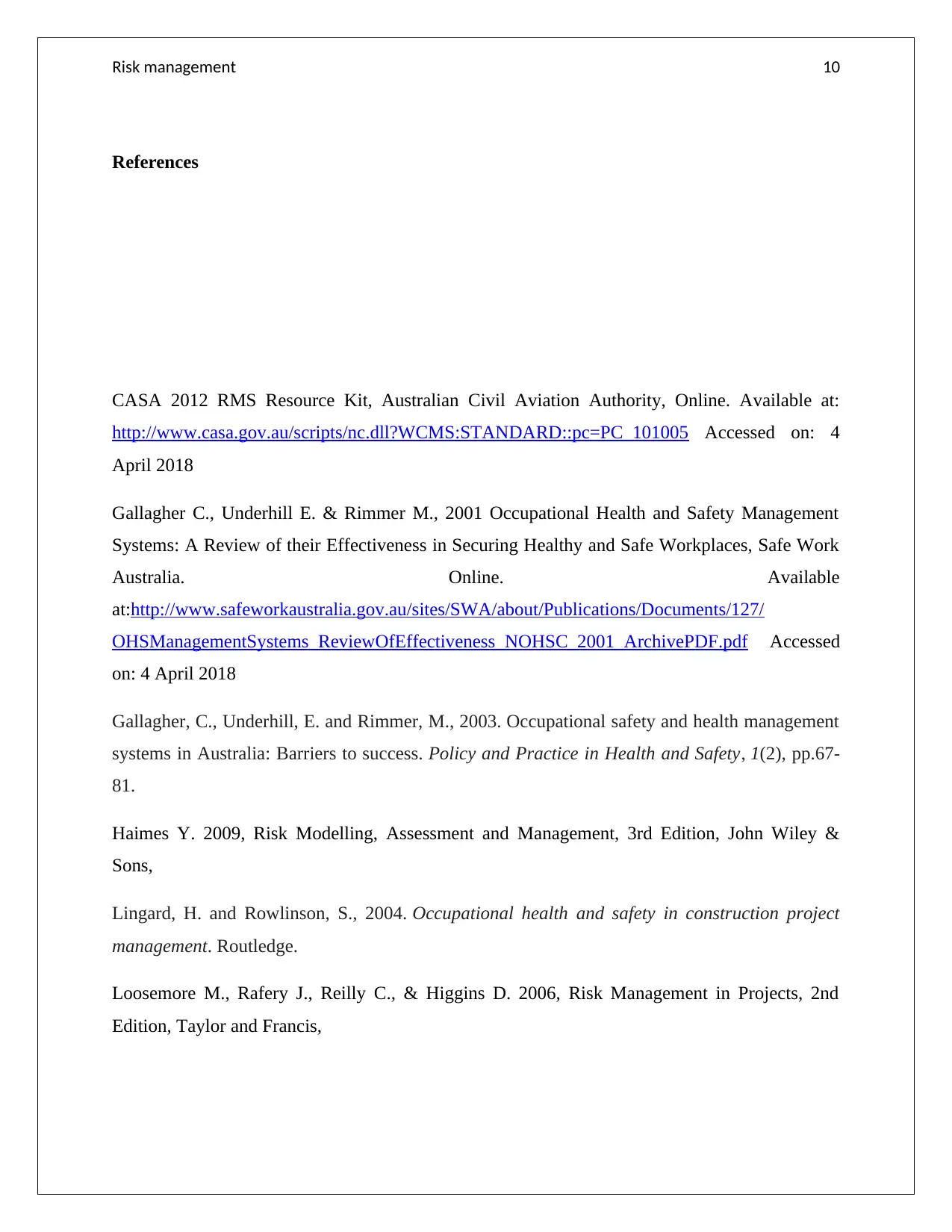
Risk management 10
References
CASA 2012 RMS Resource Kit, Australian Civil Aviation Authority, Online. Available at:
http://www.casa.gov.au/scripts/nc.dll?WCMS:STANDARD::pc=PC_101005 Accessed on: 4
April 2018
Gallagher C., Underhill E. & Rimmer M., 2001 Occupational Health and Safety Management
Systems: A Review of their Effectiveness in Securing Healthy and Safe Workplaces, Safe Work
Australia. Online. Available
at:http://www.safeworkaustralia.gov.au/sites/SWA/about/Publications/Documents/127/
OHSManagementSystems_ReviewOfEffectiveness_NOHSC_2001_ArchivePDF.pdf Accessed
on: 4 April 2018
Gallagher, C., Underhill, E. and Rimmer, M., 2003. Occupational safety and health management
systems in Australia: Barriers to success. Policy and Practice in Health and Safety, 1(2), pp.67-
81.
Haimes Y. 2009, Risk Modelling, Assessment and Management, 3rd Edition, John Wiley &
Sons,
Lingard, H. and Rowlinson, S., 2004. Occupational health and safety in construction project
management. Routledge.
Loosemore M., Rafery J., Reilly C., & Higgins D. 2006, Risk Management in Projects, 2nd
Edition, Taylor and Francis,
References
CASA 2012 RMS Resource Kit, Australian Civil Aviation Authority, Online. Available at:
http://www.casa.gov.au/scripts/nc.dll?WCMS:STANDARD::pc=PC_101005 Accessed on: 4
April 2018
Gallagher C., Underhill E. & Rimmer M., 2001 Occupational Health and Safety Management
Systems: A Review of their Effectiveness in Securing Healthy and Safe Workplaces, Safe Work
Australia. Online. Available
at:http://www.safeworkaustralia.gov.au/sites/SWA/about/Publications/Documents/127/
OHSManagementSystems_ReviewOfEffectiveness_NOHSC_2001_ArchivePDF.pdf Accessed
on: 4 April 2018
Gallagher, C., Underhill, E. and Rimmer, M., 2003. Occupational safety and health management
systems in Australia: Barriers to success. Policy and Practice in Health and Safety, 1(2), pp.67-
81.
Haimes Y. 2009, Risk Modelling, Assessment and Management, 3rd Edition, John Wiley &
Sons,
Lingard, H. and Rowlinson, S., 2004. Occupational health and safety in construction project
management. Routledge.
Loosemore M., Rafery J., Reilly C., & Higgins D. 2006, Risk Management in Projects, 2nd
Edition, Taylor and Francis,
Paraphrase This Document
Need a fresh take? Get an instant paraphrase of this document with our AI Paraphraser
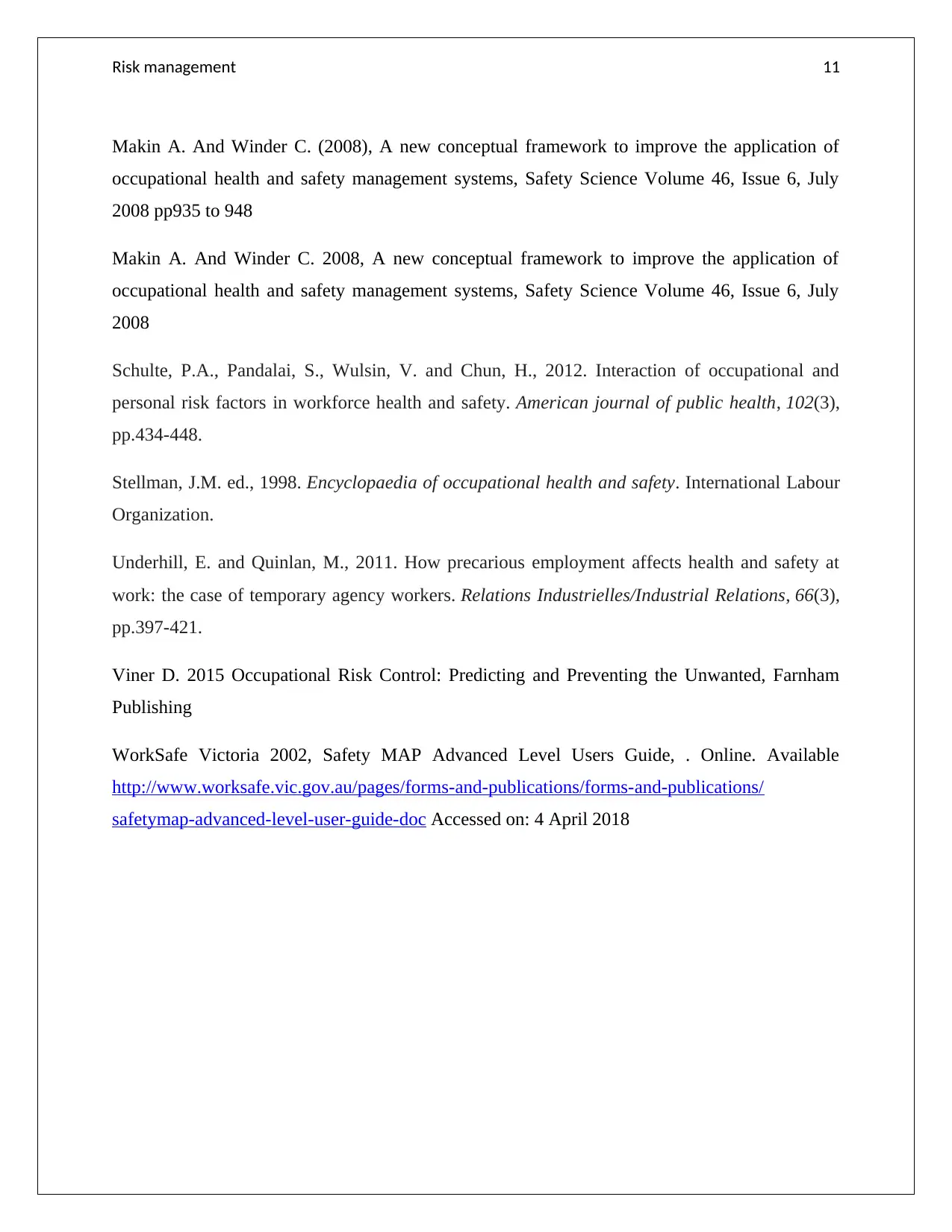
Risk management 11
Makin A. And Winder C. (2008), A new conceptual framework to improve the application of
occupational health and safety management systems, Safety Science Volume 46, Issue 6, July
2008 pp935 to 948
Makin A. And Winder C. 2008, A new conceptual framework to improve the application of
occupational health and safety management systems, Safety Science Volume 46, Issue 6, July
2008
Schulte, P.A., Pandalai, S., Wulsin, V. and Chun, H., 2012. Interaction of occupational and
personal risk factors in workforce health and safety. American journal of public health, 102(3),
pp.434-448.
Stellman, J.M. ed., 1998. Encyclopaedia of occupational health and safety. International Labour
Organization.
Underhill, E. and Quinlan, M., 2011. How precarious employment affects health and safety at
work: the case of temporary agency workers. Relations Industrielles/Industrial Relations, 66(3),
pp.397-421.
Viner D. 2015 Occupational Risk Control: Predicting and Preventing the Unwanted, Farnham
Publishing
WorkSafe Victoria 2002, Safety MAP Advanced Level Users Guide, . Online. Available
http://www.worksafe.vic.gov.au/pages/forms-and-publications/forms-and-publications/
safetymap-advanced-level-user-guide-doc Accessed on: 4 April 2018
Makin A. And Winder C. (2008), A new conceptual framework to improve the application of
occupational health and safety management systems, Safety Science Volume 46, Issue 6, July
2008 pp935 to 948
Makin A. And Winder C. 2008, A new conceptual framework to improve the application of
occupational health and safety management systems, Safety Science Volume 46, Issue 6, July
2008
Schulte, P.A., Pandalai, S., Wulsin, V. and Chun, H., 2012. Interaction of occupational and
personal risk factors in workforce health and safety. American journal of public health, 102(3),
pp.434-448.
Stellman, J.M. ed., 1998. Encyclopaedia of occupational health and safety. International Labour
Organization.
Underhill, E. and Quinlan, M., 2011. How precarious employment affects health and safety at
work: the case of temporary agency workers. Relations Industrielles/Industrial Relations, 66(3),
pp.397-421.
Viner D. 2015 Occupational Risk Control: Predicting and Preventing the Unwanted, Farnham
Publishing
WorkSafe Victoria 2002, Safety MAP Advanced Level Users Guide, . Online. Available
http://www.worksafe.vic.gov.au/pages/forms-and-publications/forms-and-publications/
safetymap-advanced-level-user-guide-doc Accessed on: 4 April 2018
1 out of 11
Related Documents
Your All-in-One AI-Powered Toolkit for Academic Success.
+13062052269
info@desklib.com
Available 24*7 on WhatsApp / Email
![[object Object]](/_next/static/media/star-bottom.7253800d.svg)
Unlock your academic potential
Copyright © 2020–2025 A2Z Services. All Rights Reserved. Developed and managed by ZUCOL.



